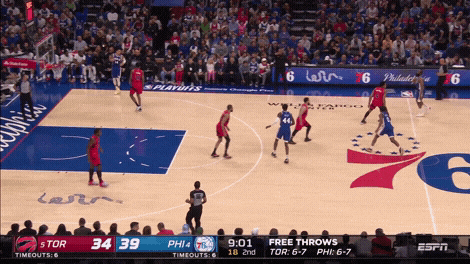
Tyrese Maxey was in a scoring zone against the Raptors in Game 1 of the series.
In Game 1 of their first round series with the Toronto Raptors, the Philadelphia 76ers recorded the third most efficient playoff performance in the 26 years for which we have play-by-play data, scoring 131 points on 89 offensive possessions.
Most efficient playoff performances, since 1997
| Date | Team | Opponent | Round | Game | PTS | Poss. | OffRtg |
|---|---|---|---|---|---|---|---|
| May. 3, 2002 | Boston | vs. Philadelphia | First round | 5 | 120 | 81 | 148.1 |
| Aug. 25, 2020 | LA Clippers | vs. Dallas | First round | 5 | 154 | 104 | 148.1 |
| Apr. 16, 2022 | Philadelphia | vs. Toronto | First round | 1 | 131 | 89 | 147.2 |
| May. 16, 2001 | Philadelphia | vs. Toronto | Conf. semis | 5 | 121 | 83 | 145.8 |
| Apr. 16, 2016 | Miami | vs. Charlotte | First round | 1 | 123 | 85 | 144.7 |
OffRtg = Points scored per 100 possessions
And they did it with Joel Embiid (19) and James Harden (22) combining for just 41 points on 11-for-32 shooting from the field. The Sixers’ offensive stars were Tyrese Maxey (38 points, 14-for-21 shooting) and Tobias Harris (26 points, 9-for-14).
Of course, those guys don’t have those kinds of performances without the attention the Raptors paid to Embiid and Harden. Toronto’s is an aggressive defense, one that will load up to the ball. It can get beat off the pass, but it makes its bones by being disruptive. The Raptors ranked in the bottom half of the league in opponent effective field goal percentage, opponent free throw rate, and defensive rebounding percentage. But it ranked ninth overall (109.9 points allowed per 100 possessions), because it led the league in opponent turnover rate (16.2 per 100 possessions).
On Saturday, we saw the negatives of the Raptors’ defense without the positives. Philly committed only *three turnovers, tied for the fewest in a playoff game in the 45 years since the league started counting them. But the Sixers did take advantage of the Raptors’ attention on the ball.
* Note that, when a defender strips the opponent has he’s going up for a shot, it can initially be interpreted as a turnover, but it’s usually scored as a block. That was was the case with Fred VanVleet’s two blocks on Saturday. So the Raptors’ defense was a little more disruptive than the turnover count would indicate.
Here are a few examples:
1. Zoning up vs. the iso
According to Second Spectrum tracking, the Raptors switched 55% of the Sixers’ ball screens on Saturday, having switched just 24% of ball-screens (the league’s 14th highest rate) in the regular season. That had the Sixers playing some one-on-one, but with lots of Raptor eyes on the ball.
Late in the first quarter, Harden drew a switch onto Precious Achiuwa with an early drive. He brought Achiuwa out to the perimeter and two Raptors — Chris Boucher and Pascal Siakam — sagged off their assignments on the strong side of the floor. Harden quickly got the ball to Maxey for a catch-and-shoot 3:

Siakam was upset at Boucher after that shot, but a few minutes earlier, Siakam himself gave up a Harris corner 3 when he shaded over toward a Harden iso on OG Anunoby (after a ball-screen switch).
2. Attacking the seam
In the regular season, Maxey shot 74-for-164 (45.1%) on catch-and-shoot 3-pointers, the ninth best mark among 239 players who attempted at least 100. But he isn’t just an off-ball threat because he can shoot. He’s also one of the quickest players in the league. That was a weapon in transition on Saturday, but also in the Sixers’ half-court offense.
Early in the second quarter, Maxey set a ball screen for Harden. VanVleet switched the screen, Maxey flared to the right wing, and attacked the seam in the Toronto defense before Scottie Barnes could recover from getting hit by the pick.

3. Beating the scram
Maxey didn’t have to set the screen in order to take advantage of the Raptors’ slow recovery. Early in the third quarter, the Raptors switched a Harden-Embiid pick and roll, putting VanVleet on the Sixers center. The Raps executed a “scram” switch, with VanVleet and Barnes trading assignments, but they were too slow. Harden quickly got the ball to Maxey, who drove baseline before VanVleet could get in front of him:

Room for improvement
Maxey’s quickness is a serious weapon against a rotating or overloading defense. And Harden (who had 14 assists in Game 1) deserves credit for the quick and sharp passes that punished the Raptors.
The Sixers were 16-for-32 from 3-point range on Saturday, the eighth time in 83 games this season that they’ve made at least half of their attempts from beyond the arc. And the Raptors can certainly expect to have better luck in that regard in Game 2 on Monday (7:30 ET, TNT).
But going forward, Toronto has to be sharper defensively — more pressure on the ball, quicker with rotations and close-outs — than it was in Game 1. Maxey didn’t just beat them off the ball. They also failed to contain him in the pick and roll a couple of times:

Of course, defending at a high level will be more difficult without Barnes (ankle sprain), Gary Trent Jr. (illness) and Thaddeus Young (thumb injury). All three are listed as doubtful for Game 2, and we can probably expect Achiuwa (Embiid’s primary defender in Game 1) to start in Barnes’ place.
* * *
John Schuhmann is a senior stats analyst for NBA.com. You can e-mail him here, find his archive here and follow him on Twitter.
The views on this page do not necessarily reflect the views of the NBA, its clubs or Turner Broadcasting.










